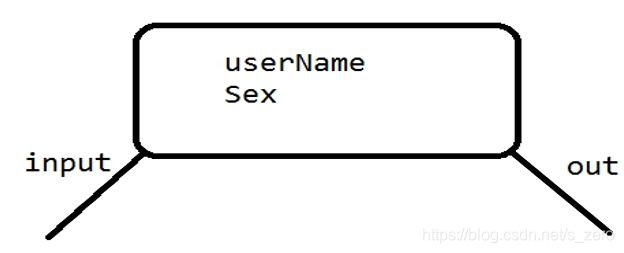1. 多线程之间如何实现通讯
1.1 什么是多线程之间通讯?
多线程之间通讯,其实就是多个线程在操作同一个资源,但是操作的动作不同。
1.2 多线程之间通讯需求
需求:第一个线程写入(input)用户,另一个线程取读取(out)用户.实现读一个,写一个操作。

2. 代码实现
- 共享资源源实体类,两个线程将会对类中变量进行读和写操作
class Res {
public String userSex;
public String userName;
}
- 写线程资源
class IntThrad extends Thread {
private Res res;
public IntThrad(Res res) {
this.res = res;
}
@Override
public void run() {
int count = 0;
while (true) {
if (count == 0) {
res.userName = "小明";
res.userSex = "男";
} else {
res.userName = "小紅";
res.userSex = "女";
}
count = (count + 1) % 2;
}
}
}
- 读线程
class OutThread extends Thread {
private Res res;
public OutThread(Res res) {
this.res = res;
}
@Override
public void run() {
while (true) {
System.out.println(res.userName + "--" + res.userSex);
}
}
}
运行代码
Res res = new Res();
IntThrad intThrad = new IntThrad(res);
OutThread outThread = new OutThread(res);
intThrad.start();
outThread.start();
结果 数据发生错乱,比如打印结果出现了“小军 女”,造成了线程安全问题
- 解决线程安全问题: 需要在写线程上加上synchronized 关键字,来保证写线程的原子性,同时读线程也需要加上synchronized 关键字,防止在从res中读数据的过程中数据被写线程操作,完整代码如下 :
class Res {
public String userName;
public String sex;
}
class InputThread extends Thread {
private Res res;
public InputThread(Res res) {
this.res = res;
}
@Override
public void run() {
int count = 0;
while (true) {
synchronized (res) {
if (count == 0) {
res.userName = "余胜军";
res.sex = "男";
} else {
res.userName = "小红";
res.sex = "女";
}
count = (count + 1) % 2;
}
}
}
}
class OutThrad extends Thread {
private Res res;
public OutThrad(Res res) {
this.res = res;
}
@Override
public void run() {
while (true) {
synchronized (res) {
System.out.println(res.userName + "," + res.sex);
}
}
}
}
public class ThreadDemo01 {
public static void main(String[] args) {
Res res = new Res();
InputThread inputThread = new InputThread(res);
OutThrad outThrad = new OutThrad(res);
inputThread.start();
outThrad.start();
}
}
3. wait、notify方法
- 因为涉及到对象锁,他们必须都放在synchronized中来使用. Wait、Notify一定要在synchronized里面进行使用。
- Wait必须暂定当前正在执行的线程,并释放资源锁,让其他线程可以有机会运行
- notify/notifyall: 唤醒因锁池中的线程,使之运行
注意:一定要在线程同步中使用,并且是同一个锁的资源
class Res {
public String userSex;
public String userName;
//线程通讯标识
public boolean flag = false;//false时执行写线程,true时执行读线程
}
class IntThrad extends Thread {
private Res res;
public IntThrad(Res res) {
this.res = res;
}
@Override
public void run() {
int count = 0;
while (true) {
synchronized (res) {
if (res.flag) {
try {
// 当前线程变为等待,但是可以释放锁
res.wait();
} catch (Exception e) {
}
}
if (count == 0) {
res.userName = "余胜军";
res.userSex = "男";
} else {
res.userName = "小紅";
res.userSex = "女";
}
count = (count + 1) % 2;
res.flag = true;
// 唤醒当前线程
res.notify();
}
}
}
}
class OutThread extends Thread {
private Res res;
public OutThread(Res res) {
this.res = res;
}
@Override
public void run() {
while (true) {
synchronized (res) {
if (!res.flag) {
try {
res.wait();
} catch (Exception e) {
// TODO: handle exception
}
}
System.out.println(res.userName + "--" + res.userSex);
res.flag = false;
res.notify();
}
}
}
}
public class ThreaCommun {
public static void main(String[] args) {
Res res = new Res();
IntThrad intThrad = new IntThrad(res);
OutThread outThread = new OutThread(res);
intThrad.start();
outThread.start();
}
}
4. wait与sleep区别
对于sleep()方法,我们首先要知道该方法是属于Thread类中的。而wait()方法,则是属于Object类中的。
sleep()方法导致了程序暂停执行指定的时间,让出cpu该其他线程,但是他的监控状态依然保持者,当指定的时间到了又会自动恢复运行状态。
在调用sleep()方法的过程中,线程不会释放对象锁。
而当调用wait()方法的时候,线程会放弃对象锁,进入等待此对象的等待锁定池,只有针对此对象调用notify()方法后本线程才进入对象锁定池准备获取对象锁进入运行状态。
5. Lock锁
在 jdk1.5 之后,并发包中新增了 Lock 接口(以及相关实现类)用来实现锁功能,Lock 接口提供了与 synchronized 关键字类似的同步功能,但需要在使用时手动获取锁和释放锁。
5.2 Lock写法
Lock lock = new ReentrantLock();
lock.lock();
try{
//可能会出现线程安全的操作
}finally{
//一定在finally中释放锁
//也不能把获取锁在try中进行,因为有可能在获取锁的时候抛出异常
lock.ublock();
}
5.2 Lock与synchronized 关键字的区别
Lock 接口可以尝试非阻塞地获取锁 当前线程尝试获取锁。如果这一时刻锁没有被其他线程获取到,则成功获取并持有锁。
Lock 接口能被中断地获取锁 与 synchronized 不同,获取到锁的线程能够响应中断,当获取到的锁的线程被中断时,中断异常将会被抛出,同时锁会被释放。
Lock 接口在指定的截止时间之前获取锁,如果截止时间到了依旧无法获取锁,则返回。
5.3 Condition用法
Condition的功能类似于在传统的线程技术中的,Object.wait()和Object.notify()的功能。
扫描二维码关注公众号,回复:
9421736 查看本文章


Condition condition = lock.newCondition();
res. condition.await(); 类似wait
res. Condition. Signal() 类似notify
代码 :
class Res {
public String userName;
public String sex;
public boolean flag = false;
Lock lock = new ReentrantLock();
}
class InputThread extends Thread {
private Res res;
Condition newCondition;
public InputThread(Res res, Condition newCondition) {
this.res = res;
this.newCondition=newCondition;
}
@Override
public void run() {
int count = 0;
while (true) {
// synchronized (res) {
try {
res.lock.lock();
if (res.flag) {
try {
// res.wait();
newCondition.await();
} catch (Exception e) {
// TODO: handle exception
}
}
if (count == 0) {
res.userName = "余胜军";
res.sex = "男";
} else {
res.userName = "小红";
res.sex = "女";
}
count = (count + 1) % 2;
res.flag = true;
// res.notify();
newCondition.signal();
} catch (Exception e) {
// TODO: handle exception
}finally {
res.lock.unlock();
}
}
// }
}
}
class OutThrad extends Thread {
private Res res;
private Condition newCondition;
public OutThrad(Res res,Condition newCondition) {
this.res = res;
this.newCondition=newCondition;
}
@Override
public void run() {
while (true) {
// synchronized (res) {
try {
res.lock.lock();
if (!res.flag) {
try {
// res.wait();
newCondition.await();
} catch (Exception e) {
// TODO: handle exception
}
}
System.out.println(res.userName + "," + res.sex);
res.flag = false;
// res.notify();
newCondition.signal();
} catch (Exception e) {
// TODO: handle exception
}finally {
res.lock.unlock();
}
// }
}
}
}
public class ThreadDemo01 {
public static void main(String[] args) {
Res res = new Res();
Condition newCondition = res.lock.newCondition();
InputThread inputThread = new InputThread(res,newCondition);
OutThrad outThrad = new OutThrad(res,newCondition);
inputThread.start();
outThrad.start();
}
}
